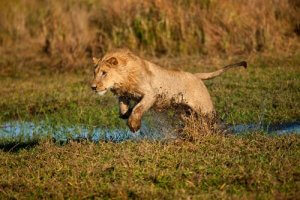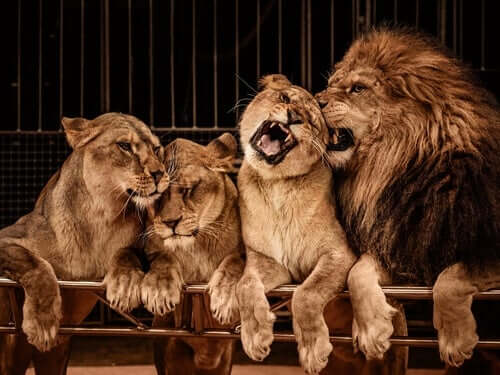Discover How Lionesses Hunt Their Prey

The organization of lions
It’s very important to know how these animals organize themselves in order to understand how lionesses hunt. These carnivorous predators are very social. Each group or pride consists of one or two males, five or six interrelated females, and cubs of both sexes. When males reach maturity, they are expelled from their mother’s care and must form their own new group.
Something similar occurs with females that have already raised their cubs. In the case that there are already too many lionesses in the harem, these “empty nesters” are kicked out. What’s more, no other pride will take them in. Their only option is to join up with another solitary female and form a new pride once they find a male.

How to lionesses hunt: Techniques
First, let’s analyze the physique of the males and females of this species. If you take into consideration their features, you can understand why females are more suited to hunting than males. Lionesses are smaller, faster, and stand out much less because they don’t possess a mane.
When lionesses hunt, the procedure requires a certain amount of organization. It’s common for them to go out in teams of two or more. They hunt among the dry grass, which is the same color as their fur, and then wait for the appearance of some tempting prey. For example, a gazelle that’s lost, sick, or old is the perfect target for an attack.
In this sense, lionesses may spend hours waiting for just the right moment to start their chase. For example, they approach a herd, thus causing the animals to flee in a stampede. But there’s always some more vulnerable individual from the herd that straggles behind. This is the animal the lionesses will attack.
It’s worth pointing out that, when it comes to hunting, lionesses are much more active during the night. What’s more, their diet consists mainly of zebras, impalas, wildebeests. However, on occasion, they may also consume giraffes, gazelles, and even buffalos. In these cases, a male may step in to take part in the hunt.
While it’s true that lions aren’t very resistant, given that their hearts aren’t very big, they are strong. What’s more, they possess powerful claws and fangs that help them defeat their prey. Their attacks are short and very powerful. In fact, in one jump, they can overcome an animal and strangle or suffocate it by covering its nose and mouth.
Dinner is served!
Once lionesses have killed their prey, the male is the first to get his share… which is the best and freshest part of the kill. When the male is full, then the hunters and other lionesses in the pride have their turn to dine. Cubs are the last to have their go at whatever is left. In times of scarcity, this reality can cause some cubs to die of hunger.
If a lioness approaches the food before the male is finished, he will demonstrate his power by growling and showing his claws. This is enough for the female to wait her turn. And while it seems contradictory and, at the same time, interesting, males are more likely to allow the cubs to eat with them than they are to share with the lionesses.
Once the meal is over, males will take some time to rest and digest. In fact, they can spend up to 20 hours a day sleeping, waking up only when they’re hungry. Males may also take the rest of the prey up into a tree in order to eat whenever they want… especially in order to avoid scavengers like vultures and even hyenas from “stealing” their food.
https://misanimales.com/como-cazan-las-leonas/
The organization of lions
It’s very important to know how these animals organize themselves in order to understand how lionesses hunt. These carnivorous predators are very social. Each group or pride consists of one or two males, five or six interrelated females, and cubs of both sexes. When males reach maturity, they are expelled from their mother’s care and must form their own new group.
Something similar occurs with females that have already raised their cubs. In the case that there are already too many lionesses in the harem, these “empty nesters” are kicked out. What’s more, no other pride will take them in. Their only option is to join up with another solitary female and form a new pride once they find a male.

How to lionesses hunt: Techniques
First, let’s analyze the physique of the males and females of this species. If you take into consideration their features, you can understand why females are more suited to hunting than males. Lionesses are smaller, faster, and stand out much less because they don’t possess a mane.
When lionesses hunt, the procedure requires a certain amount of organization. It’s common for them to go out in teams of two or more. They hunt among the dry grass, which is the same color as their fur, and then wait for the appearance of some tempting prey. For example, a gazelle that’s lost, sick, or old is the perfect target for an attack.
In this sense, lionesses may spend hours waiting for just the right moment to start their chase. For example, they approach a herd, thus causing the animals to flee in a stampede. But there’s always some more vulnerable individual from the herd that straggles behind. This is the animal the lionesses will attack.
It’s worth pointing out that, when it comes to hunting, lionesses are much more active during the night. What’s more, their diet consists mainly of zebras, impalas, wildebeests. However, on occasion, they may also consume giraffes, gazelles, and even buffalos. In these cases, a male may step in to take part in the hunt.
While it’s true that lions aren’t very resistant, given that their hearts aren’t very big, they are strong. What’s more, they possess powerful claws and fangs that help them defeat their prey. Their attacks are short and very powerful. In fact, in one jump, they can overcome an animal and strangle or suffocate it by covering its nose and mouth.
Dinner is served!
Once lionesses have killed their prey, the male is the first to get his share… which is the best and freshest part of the kill. When the male is full, then the hunters and other lionesses in the pride have their turn to dine. Cubs are the last to have their go at whatever is left. In times of scarcity, this reality can cause some cubs to die of hunger.
If a lioness approaches the food before the male is finished, he will demonstrate his power by growling and showing his claws. This is enough for the female to wait her turn. And while it seems contradictory and, at the same time, interesting, males are more likely to allow the cubs to eat with them than they are to share with the lionesses.
Once the meal is over, males will take some time to rest and digest. In fact, they can spend up to 20 hours a day sleeping, waking up only when they’re hungry. Males may also take the rest of the prey up into a tree in order to eat whenever they want… especially in order to avoid scavengers like vultures and even hyenas from “stealing” their food.
https://misanimales.com/como-cazan-las-leonas/
This text is provided for informational purposes only and does not replace consultation with a professional. If in doubt, consult your specialist.








